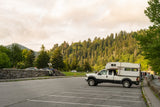Overlanding is all about exploring off the grid, but getting stranded in the middle of nowhere without power can turn your fun adventure into a dangerous situation. Luckily, TAXA habitats are built with power systems to keep you off-roading and out of harm’s way. In this article, we’ll explore the various power systems you’ll find in overlanding vehicles and help you determine how much power you’ll need for your adventure.
Importance of reliable power while overlanding
You need more than “just enough” power when you’re overlanding because if you’re venturing through the great outdoors, the last thing you want is to be sitting in your trailer without power in an isolated area. Without electricity in your trailer, your heating and cooling systems won’t work, you won’t be able to cook anything, you won’t be able to take a hot shower, and your lighting systems won’t turn on. That’s why it’s imperative that you use an overlanding vehicle with a reliable power system that provides sufficient power and consistent electricity.
Basics of overland power setups & electrical systems
When you’re out on an adventure, you need to be prepared beyond your basic overlanding necessities. Knowing the basics of your power setup will help you navigate any unexpected challenges that come your way. Overlanding power systems involve a basic electrical setup to provide power for essential devices and amenities during your adventures. In this section, we’ll take an in-depth look at the major components of overlanding power setups, which include batteries, power inverters, charge controllers, fuses, and switches.
Power sources
Overlanding power setups typically rely on the main battery of your tow vehicle but are augmented with their own battery systems as well that gain charge from the tow vehicle. TAXA’s habitats also include shore and solar power capabilities to charge your adventure vehicle with solar energy.
Batteries
Overlanding trailers use battery power to supply electricity for various amenities like LED lighting, 12-volt and USB-powered appliances, water pumps, water heaters, furnaces, and refrigerators. The primary purpose of batteries in an overlanding trailer is to store electrical energy generated from external power sources like the tow vehicle's alternator, solar panels, or generator.
Battery types
There are multiple types of batteries that are commonly used in overlanding trailers. TAXA habitats use AGM batteries, though lithium batteries are a common upgrade. Here is a brief rundown of the overlanding batteries you’re likely to encounter as you’re researching overlanding power setups:
- Lithium Ion - this type of battery offers excellent energy density, safety, and long cycle life, making it well-suited for overlanding applications. These batteries are lightweight and provide more energy for their size and weight. They also charge quickly, allowing for efficient use of available charging sources.
- AGM - Absorbent Glass Mat batteries are an advanced version of the traditional lead acid battery and are known for their durability, minimal maintenance requirements, and ability to handle deep discharges. They also perform well despite temperature fluctuations, but their capacity may decrease at extremely low temperatures.
- Lead Acid - lead acid batteries are reasonably priced, widely available, and relatively durable. But, they have a limited lifespan, a lower energy density, and can be very sensitive to extreme temperatures.
Power inverter
A power inverter is an electrical device that converts direct current (DC) electricity, typically from a battery, into alternating current (AC) electricity, which is commonly used to power appliances and devices in your trailer, like laptops, chargers, and entertainment systems. These devices enable you to harness the energy stored in your trailer's batteries and use it to operate a wider range of devices.
Charge controller
A charge controller regulates the charging of batteries in a power system. It manages the flow of electrical energy from solar panels, generators, or other charging sources to prevent overcharging and potential damage to the batteries. In an overlanding trailer's power system, the charge controller optimizes the charging process, which extends the battery lifespan and supports a consistent power supply.
Fuses & switches
Fuses are designed to interrupt the flow of electrical current in case of a fault or overload. They act as safeguards, preventing damage to the trailer’s wiring and components by breaking the circuit when the current exceeds a certain threshold. Switches, on the other hand, allow you to manually open or close an electrical circuit. They control the flow of power to different appliances, lights, and devices in the trailer.
How much power do you need?
In order to calculate your energy needs before going overlanding, there are a few things you need to consider first. These include how many devices you need to power, an estimate of your daily power consumption, the capacity of your batteries, and the power ratings of each device you need to power.
Here’s a general equation you can use to give you an estimate of the energy storage capacity needed for your overlanding trip:
Total Energy Requirement (Wh) = (Adjusted Daily Energy Requirement) x (Number of Overlanding Days).
Remember that if you're using multiple battery types, you'll need to consider their specific voltage and capacity ratings in your calculations. Also, the efficiency of charging sources, battery charging rate, and external factors like weather can influence your calculations.
Producing electricity — overlanding power sources
Now that we can calculate how much energy is needed for adventuring, let’s explore the primary power sources used by overlanders. These sources range from propane and gas to solar energy.
Propane
Propane can power devices like stoves, heaters, water heaters, and refrigerators, making it a one-stop solution for cooking, heating, and maintaining a comfortable living space on the road. The main advantages of propane include its high energy density, portability, and relatively clean combustion. However, it also comes with some drawbacks, like the need to carry and store propane tanks and the need for proper ventilation when using appliances that burn propane. All TAXA habitats come with propane tanks as a primary power source to take advantage of these benefits while catering to the specific needs of overlanding travelers.
Gas
Gasoline is a common power source for overlanding setups due to its convenience, especially in tow vehicles that use internal combustion engines. Gas powers the vehicle's engine, as well as generators or charging systems, which provide electricity to appliances and accessories in the overlanding setup. The main advantages of gasoline include its higher energy density compared to other liquid fuels, ease of refueling, and the fact that many vehicles are already equipped with gasoline engines. But, this power source also has downsides, including potential volatility, safety concerns, environmental impact, and the need to carry additional fuel containers.
Solar
On the other hand, solar power is chosen for its environmentally friendly benefits, reduced dependency on fossil fuels, and suitability for remote locations where access to traditional power sources may be limited. Solar power systems can charge auxiliary batteries, power appliances, and even provide energy during stops, but solar power can also be affected by weather conditions and might not provide consistent power output, especially in cloudy or shaded areas. However, all TAXA habitats are pre-wired for solar energy, making it an easy switch from traditional sources or giving a convenient boost to your current power setup.
Storing electricity — overlanding battery setup
Now that we've established how power is generated, the next step is to determine suitable storage solutions for that electricity:
Lithium battery setup
As mentioned earlier, lithium-ion batteries offer high energy density and a longer lifespan compared to traditional lead-acid batteries. To implement this setup, you'd replace or supplement your existing battery bank with lithium-ion batteries and connect them to a battery management system (BMS) that ensures safe charging and discharging. The BMS monitors individual cells, prevents overcharging, and balances the state of charge. An inverter can then be added to convert power from the batteries into power for devices.
Dual battery setup
A dual battery setup involves having two separate batteries in your overlanding trailer — one for essential vehicle functions and another for powering accessories and amenities. The primary vehicle battery is dedicated to starting the engine, while the auxiliary battery powers devices like lights, the fridge, and more. To implement this setup, you'd use a battery isolator or separator to ensure that the auxiliary battery charges when the engine is running but doesn't drain power from the primary battery when the engine is off. Wiring connects the batteries and the isolator, while fuses and switches manage power distribution.
Alternator battery setup
An alternator battery setup involves using your vehicle's alternator to charge an auxiliary battery in your overlanding trailer while driving, allowing you to replenish your trailer's battery bank while on the move. To implement this setup, install a charging relay or solenoid that connects the auxiliary battery to the alternator when the engine is running. This relay closes the circuit and allows the charging current to flow from the alternator to the trailer's batteries. When the engine is off, the relay opens, preventing the trailer's batteries from draining the vehicle's battery.
Solar battery setup
As the name suggests, this setup involves using solar panels to generate electricity. To implement this setup, mount solar panels on the roof of your trailer and connect them to a charge controller, which regulates the charging process and prevents overcharging. The charge controller then sends the generated electricity to your battery bank for storage. Wiring, fuses, and switches manage power distribution to appliances and devices. Thankfully, if you have a TAXA, this is all pre-wired and is a very easy setup to implement.
Get the ultimate overlanding setup with TAXA
Now that you understand the basics of overlanding power setups, battery types, and the advantages and disadvantages of each, you can go wherever the journey takes you without worrying about your energy needs. TAXA’s range of adventure vehicles provides the durability, functionality, and adaptiveness you need to conquer any road.
Need help determining which overlanding vehicle is right for you? TAXA makes it easy to find your perfect match. With our diverse range of carefully designed and ruggedly built overlanding vehicles, you can explore the great outdoors with confidence and comfort. Contact one of our adventure specialists today or learn more about our habitats and find the right overlanding habitat for your next expedition.

